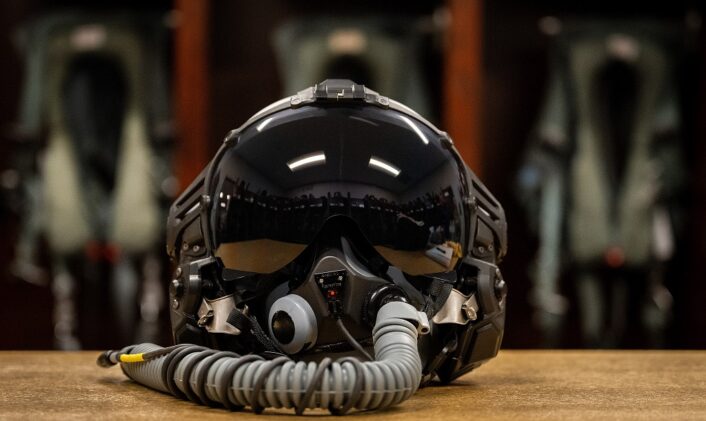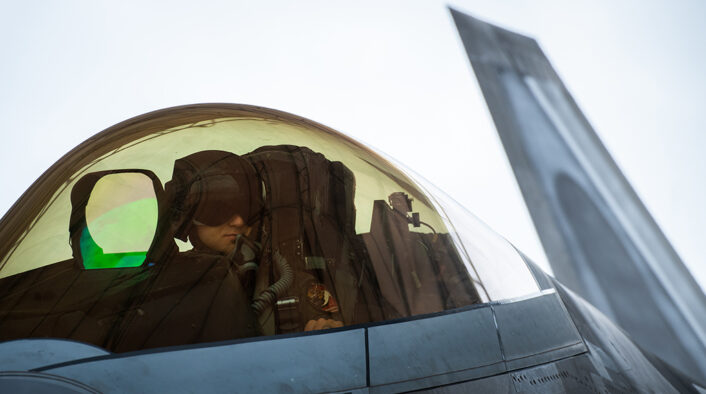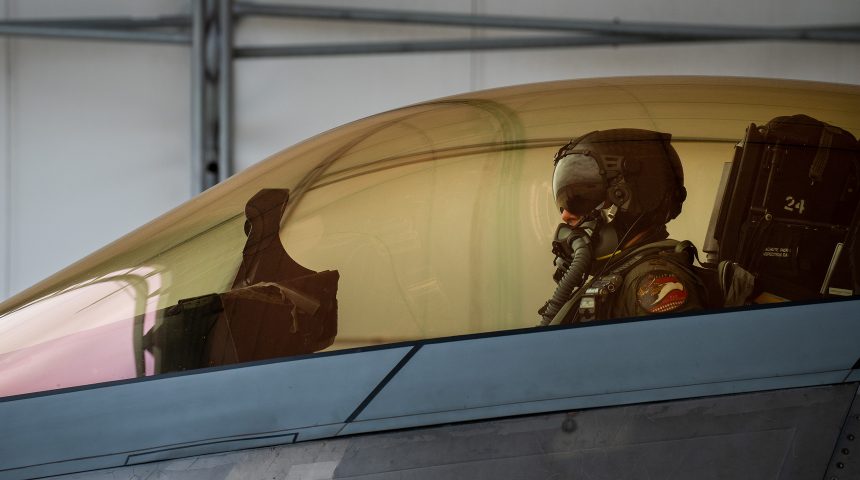Raptor pilots are now testing a new type of flight helmet.
The U.S. Air Force is finally testing a new helmet design for fixed wing pilots, developed around pilots’ needs and feedback from using the current HGU-55P helmet, which has been the standard issued helmet for the last 40 years. The testing is currently underway at Eglin Air Force Base, where approximately five F-22A Raptor pilots from the 301st Fighter Squadron, a Reserve unit with the 43rd Fighter Squadron, are flying with the new lighter, cooler and more readily equipped helmet.
The Next Generation Fixed Wing Helmet program goal is to provide pilots a more comfortable, stable, and balanced platform to accommodate helmet-mounted devices usage without imposing neck strain and discomfort to the user. The new helmet will equip support, bomber and fighter aircraft pilots, with the exception of F-35 who will continue to fly with their current helmet.

“It is common knowledge fighter pilots have long term neck and back issues,” said Maj. Brett Gedman, from the 301st Fighter Squadron. “Therefore, having a lightweight helmet, designed with the operator in mind, will have positive long-term impacts on the health of our fighter pilots during and after service.”
This series of tests, which is being overseen by the 46th Test Squadron and the 28th Test and Evaluation Squadron, marks the second round of developmental tests with the LIFT-manufactured helmet since it was awarded the contract in 2022. Another round of testing will be performed once the Raptor complete their move from Eglin Joint Base Langley-Eustis, Virginia, which will be followed by testing on the HC-130J and B-1B Lancer.
“The current helmet was based on 1980’s design. Since then, gains in aircraft technology and the demographic of pilots have changed,” said Scott Cota, ACC Plans and Requirements branch aircrew flight equipment program analyst last year. “The legacy helmet was not originally designed to support advances in aircraft helmet-mounted display systems, causing pilots to fly with equipment not optimized for them, especially our female aircrew.”

Interestingly, according to LIFT, the new helmet design incorporates a wide range of updated technologies: “Active Noise Reduction (ANR) is a standard issue feature which improves speech intelligibility across a wide frequency spectrum, helping to protect crew members from stress and fatigue. The Aircrew Mounted Power Supply (AMPS) is an off-helmet unit, which reduces weight, and helps extend the life of the helmet through it’s rechargeable lithium-ion batteries (reducing battery waste). Additional features include Improved stability, a reduced helmet size to aid in better ‘mass properties’, a carbon fiber shell to reduce helmet weight and crew member neck strain, and a “custom fit system” to provide a more comfortable fit for male and female aircrew members.”
Different configurations are available including JHMCS (Joint Helmet Mounted Cueing System) and NVG (Night Vision Goggles). The new helmet can also be fitted with the nuclear flash protective goggles. Unlike the old HGU-55/P, whose addition of the various attachments and mounts required hours of fitting and significantly altered the balance of the helmet, contributing to the neck and back issues widespread among pilots, the new helmet is much more comfortable and ergonomic, and was designed to allow the user one-handed operations (raising and lowering of the visor, activation of the illumination, etc). Another really interesting feature is the magnetic chin strap, that allows the user to mate the strap with a single hand, in a similar way to what happens with the the modern commercial ski helmets.

The shape and size of the NGFWH allow for more mobility and visibility, as well as more comfort in the cockpit. It’s not clear whether the size of the new helmet has been reduced enough to allow the helmet-mounted cueing system to be compatible with the F-22 canopy.
Today, most of the combat aircraft (including today use a Helmet Mounted Display: with an HMD (like the JHMCS, the F-35’s HMD or the Eurofighter HMSS), information imagery (including aircraft’s airspeed, altitude, weapons status, aiming etc) are projected on the visor enabling the pilot to look out in any direction with all the required data always in his field of vision. For instance, the HMD enables the pilot to engage a target with a missile by simply looking at it.
Despite various integration efforts in the past, the F-22 is not equipped yet with a helmet that provides the essential flight and weapon aiming information through line of sight imagery: the shape of the Raptor’s canopy, optimized to preserve Low Observability, doesn’t allow enough range of motion and minimum visibility to a pilot wearing the JHMCS or the Scorpion.
Anyway, back to the NGFWH testing, after each flight, the F-22 pilots provide a feedback about wearability, visibility, communication, etc after each flight, allowing the engineers to compile data that will help the manufacturer to fix and improve the helmet.









